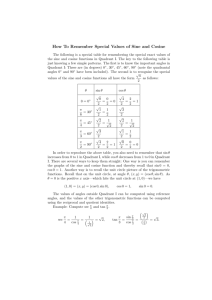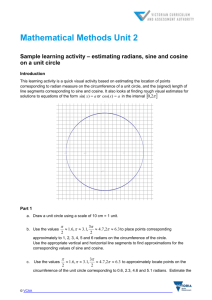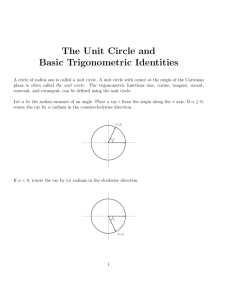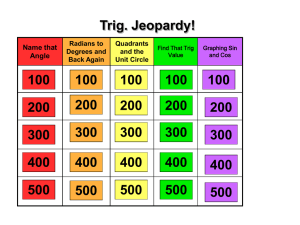Math 175 Trigonometry Worksheet We begin with the unit circle. The
advertisement
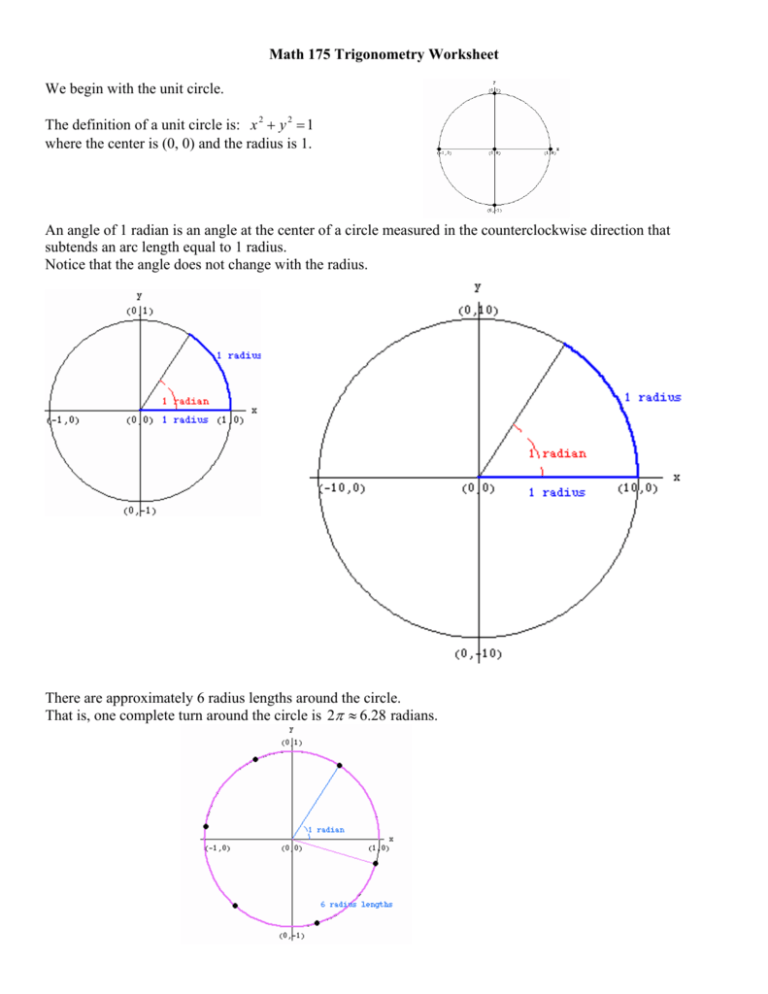
Math 175 Trigonometry Worksheet We begin with the unit circle. The definition of a unit circle is: x 2 + y 2 = 1 where the center is (0, 0) and the radius is 1. An angle of 1 radian is an angle at the center of a circle measured in the counterclockwise direction that subtends an arc length equal to 1 radius. Notice that the angle does not change with the radius. There are approximately 6 radius lengths around the circle. That is, one complete turn around the circle is 2π ≈ 6.28 radians. Define the Sine and Cosine functions: Choose P(x, y) a point on the unit circle where the terminal side of θ intersects with the circle. Then cos θ = x and sin θ = y . We see that the Pythagorean Identity follows directly from these definitions: x2 + y2 =1 (cosθ ) 2 + (sin θ ) 2 = 1 we know it as : sin 2 θ + cos2 θ = 1 Example 1. Determine: sin(90°) and cos(90°) Recall that 90° corresponds to π 2 Example 2. Determine: sin(3π ) and cos(3π ) radians . We can read the answers from the graphs: ⎛π ⎞ sin(90°) = sin⎜ ⎟ = y coordinate of P = 1 ⎝2⎠ ⎛π ⎞ cos(90°) = cos⎜ ⎟ = x coordinate of P = 0 ⎝2⎠ (How many degrees do 3π radians correspond to?) sin(3π ) = sin(540°) = y coordinate of P = 0 cos(3π ) = cos(540°) = x coordinate of P = −1 Problems 1 and 2: 1. Locate the following angles on a unit circle and find their sine and cosine. 5π 5π b. c. 360° d. −π a. − 2 2 2. Given: cos θ = 0 and sin θ = 1 . Find the following: a. the smallest positive θ that satisfies the given equalities. b. one other θ that satisfies the given equalities. Note: θ1 and θ 2 should be in radians. There are six trigonometric functions. We have considered the sine and cosine functions. We can define the four remaining in terms of these functions. sin θ cos θ The tangent function: tan θ = The cotangent function: cot θ = cosθ sin θ The cosecant function: csc θ = 1 sin θ The secant function: sec θ = 1 cos θ We know all of the above functions will have points of discontinuity where the denominator is zero. The graphs of these functions all have vertical asymptotes at these points. We will use the definition of the sine and cosine functions on the unit circle ( r = 1) to find the sine and cosine for common reference angles. cosθ = x and sin θ = y We could use the sine and cosine graphs, however the unit circle is more useful for these problems. The common angles that we are interested in are: degrees radians Consider π 4 0 0 30 π/6 45 π/4 = 45° An angle of 60 π/3 π 4 ⎛ 1 1 ⎞ P = ⎜ , ⎟. ⎝ 2 2⎠ 90 π/2 180 π 270 3π/2 360 2π radians intersects the unit circle at the point, Using the definition for sine and cosine, we have: ⎛π ⎞ 1 ⎛π ⎞ 1 sin⎜ ⎟ = and cos⎜ ⎟ = ⎝4⎠ ⎝4⎠ 2 2 Similarly, we find the sine and cosine of π 6 = 30°: ⎛π ⎞ 1 ⎛π ⎞ 3 and cos⎜ ⎟ = sin⎜ ⎟ = ⎝6⎠ 2 ⎝6⎠ 2 We can complete the chart by working in the same get: degrees radians sin θ cos θ 0 0 0 30 π/6 1/2 45 π/4 1 3 / 2 1/ 2 1/ 2 60 π/3 3/ 2 1/2 manner to 90 π/2 1 180 π 0 270 3π/2 -1 360 2π 0 0 -1 0 1 The common angles < 90° listed above will become reference angles. Problem 3. Using the table, find: tan π 6 and cot π 4 Using the definition of the sine and cosine functions on the unit circle we can find the signs of the trigonometric functions in each quadrant. cos θ = x and sin θ = y S A T C The above graph shows the results. Problems 4 through 8: 4. In which of the four quadrants is the sine function positive? 5. In which of the four quadrants is the secant function negative? 6. In which of the four quadrants is the cosecant function positive and the cosine function negative? 7. In which of the four quadrants do the tangent function and the cotangent function have the same signs? ⎛ 7π ⎞ ⎛ 7π ⎞ ⎛ 7π ⎞ 8. Find the signs of sin⎜ ⎟, cos⎜ ⎟ and tan⎜ ⎟ . ⎝ 6 ⎠ ⎝ 6 ⎠ ⎝ 6 ⎠ Recall: cosθ = x and sin θ = y We have used the definitions to find the sine and cosine of common reference angles. We have used the definitions to find the signs of the trigonometric functions in each quadrant. We can now use these definitions to evaluate the trigonometric functions of multiples of common reference angles. 2π . θ is an angle in Quadrant II. 3 We will define a Reference Triangle. A Reference Triangle is a Right Triangle formed by dropping a perpendicular line from the point, P, to the x axis. (Recall P is the point of intersection of the terminal side of θ and the unit circle.) Example 3: Consider θ = The blue triangle is The Reference Triangle. We call the acute angle at (0,0) within the triangle, φ , the reference angle. φ is closely related to θ : The sine and cosine of θ have the same magnitude as the sine and cosine of φ . Only their signs may vary. In this example, we "see" that φ = π − θ = π − ⎛π ⎞ ⎛π ⎞ 1 3 and cos⎜ ⎟ = . We know sin⎜ ⎟ = ⎝ 3⎠ 2 ⎝ 3⎠ 2 2π π = . 3 3 We know the sine function is positive in Quadrant II and the cosine function is negative in Quadrant II. ⎛ 2π ⎞ ⎛ 2π ⎞ 3 1 and cos⎜ ⎟ = − Therefore: sin⎜ ⎟ = + ⎝ 3⎠ ⎝ 3⎠ 2 2 9π . 4 What quadrant is this in? How can I find out? π π 9π 9π = 2π + = one complete revolution and more. ∴ is in Quadrant I. 4 4 4 4 The Reference Triangle is always a Right Triangle formed by dropping a perpendicular line from the point, P, to the x axis. Example 4: Consider The blue triangle is The Reference Triangle. We always call the acute angle at (0,0) within the triangle, φ , the reference angle. φ is always closely related to θ : The sine and cosine of θ have the same magnitude as the sine and cosine of φ . Only their signs may vary. In the above example, we "see" that φ = θ − 2π = ⎛π ⎞ 1 ⎛π ⎞ 1 . We know sin⎜ ⎟ = and cos⎜ ⎟ = ⎝4⎠ ⎝4⎠ 2 2 9π π − 2π = . 4 4 We know the sine function is positive in Quadrant I and the cosine function is positive in Quadrant I. ⎛ 9π ⎞ ⎛ 9π ⎞ 1 1 Therefore: sin⎜ ⎟ = + . and cos⎜ ⎟ = + ⎝ 4 ⎠ ⎝ 4 ⎠ 2 2 Problem 9. Use the method above to solve the following: ⎛ 3π ⎞ a. sin⎜− ⎟ ⎝ 4 ⎠ ⎛ 29π ⎞ b. cos⎜ ⎟ ⎝ 6 ⎠ e. csc(510°) ⎛19π ⎞ f. cot⎜ ⎟ ⎝ 3 ⎠ ⎛ 9π ⎞ d. sec⎜− ⎟ ⎝ 4 ⎠ c. tan(420°) We can use this method to solve simple trigonometric equations. Example 5: Solve the following for θ where 0 ≤ θ ≤ 2π : cos θ = 3 2 3 π is φ = . 2 6 We also know that the cosine function is positive in quadrants I and IV. We know the solution to: cos φ = Therefore our reference angle looks like this: So: θ1 = φ = π 6 and θ 2 = 2π − φ = 2π − π 6 = And our solutions look like this: 12π π 11π − = 6 6 6 There is another method of solving: cosθ = 3 . 2 3 on the 2 same set of axes and find their points of intersection. We can graph y = cosθ and y = We "see" the first point of intersection is: θ1 = π 6 11π and the second point of intersection is: θ 2 = 6 We will commonly use the first method as it is more useful for Calculus. Example 6: Solve the following for θ where 0 ≤ θ ≤ 2π : sin θ = − 3 2 3 π is φ = . 2 3 We also know that the sine function is negative in quadrants III and IV. We know the solution to: sin θ = + Therefore our reference angle looks like this: So: θ1 = π + φ = And our solutions look like this: 4π 5π and θ 2 = 2π − φ = 3 3 NOTE: Never solve this and similar problems by plugging a negative number into your calculator. With the sine function, you will get a negative angle (IV quadrant on the unit circle). With the cosine function, you will get an angle in quadrant II only. Your calculator is set up to find the inverse trigonometric functions. This is NOT what we want in these problems. To summarize this method of solving simple trigonometric equations: 1. Locate φ a small positive angle between 0 and π . 2 2. Place φ in the quadrants corresponding to the given equation. 3. Find a θ in the appropriate quadrants. 3 and sin θ is negative . 2 Find: the quadrant of θ and sec θ . Problem 10. Given: cosθ = Problem 11. Solve for θ where 0 ≤ θ ≤ 2π in the following problems. 1 1 a. cos θ = − b. tan θ = − 3 c. sin θ = 2 2 Example 7: In Example 6, Solve the following for θ where 0 ≤ θ < 2π : sin θ = − θ1 = 3 , we found 2 4π 5π and θ 2 = . How does our answer change if the question asks us to solve for all θ ? 3 3 We know that the sine function is periodic. It repeats every 2π radians. Then our solutions should also repeat every 2π radians. Our solutions become: 4 π 4π 4π 4π θ1 = , ± 2π , ± (2)2π , ± (3)2π . . . 3 3 3 3 4π ∴ in general θ1 = + (n)2π where n is an integer 3 and 5π 5π 5π 5π , ± 2π , ± (2)2π , ± (3)2π . . . 3 3 3 3 5π ∴ in general θ 2 = + (n)2π where n is an integer 3 θ2 = Problem 12. Find all the values for θ from Example 5, cosθ = 3 2 Example 8: Solve cos2π x = 0 for x in (−1,1) . π 3π 5π nπ . ∴ θ =± , ± ,± . . . where n is an odd integer . 2 2 2 2 2 nπ n 1 3 So 2π x = ⇒ x = where n is an odd integer. And for x in (−1,1) the solution is x = ± , ± . 2 4 4 4 We know cos φ = 0 when φ = ± π Problem 13. Solve the following for x on the given intervals. a. sin2π x = 0 for x in (0,2) c. cos π 3 b. tan π 2 x =− 1 for x in (1,4) 3 x = 1 for x in (−7,7) Identities: sin 2 x + cos 2 x = 1 divide by cos 2 x : tan 2 x + divide by sin 2 x : 1 1 = sec 2 x + cot 2 x = csc 2 x Double Angle Formulas : sin2x = 2sin x cos x cos2x = cos 2 x − sin 2 x = 2cos 2 x −1 = 1− 2sin 2 x Half − Angle Formulas : sin 2 x = 1− cos2x 2 cos 2 x = 1+ cos2x 2
